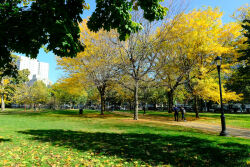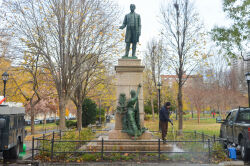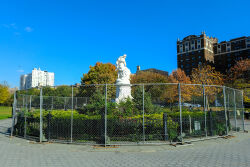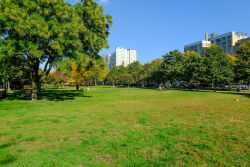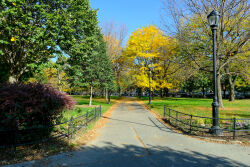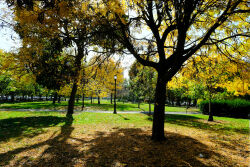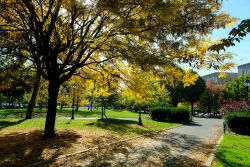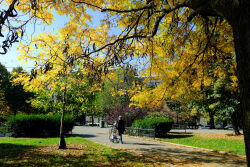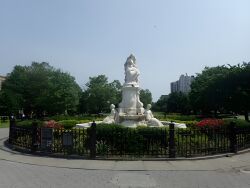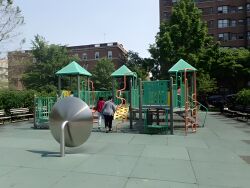Joyce Kilmer Park
View all monuments in NYC Parks, as well as temporary public art installations on our NYC Public Art Map and Guide.
Heinrich Heine Fountain
| Artist: | Ernst Herter |
| Dedicated: | July 8, 1899 |
| Location: | At southern end of park |
Artwork History
The Heinrich Heine Fountain (also known as the Lorelei Fountain) honors the German poet, writer, and social dissident Heinrich Heine (1797–1856), whose poem Die Lorelei immortalized the mysterious creature of romantic legend.
Born in Dusseldorf, Germany, Heine worked as an apprentice in a banking house and for a grocery dealer. He ran a textile business, then studied law at the University of Bonn and University of Gottingen, where he earned his law degree in 1825. From there he worked as a writer in Luneberg and Hamburg. Born to a Jewish family, Heine was prevented from pursuing a career in public administration or academics, and he moved to Paris in 1831. Associated with the Romantic movement, his autobiographical works touched on political ideas and were influenced heavily by noted Romantic Johann Wolfgang von Goethe (1749–1832).
The sculptural group, carved out of white Tyrolean marble, depicts Lorelei, a German mythical figure seated on a rock in the Rhine River among mermaids, dolphins, and seashells. According to legend, the maiden was transformed into a siren after throwing herself into the river. She could be heard singing from a rock along the river, her voice hypnotizing sailors to sleep, and then to their death. The bas-reliefs around the pedestal include a profile of Heine. Other decorative and allegorical motifs include a frog, a bird, and a skull symbolizing mortality.
As a result of a campaign by many German writers and scholars, the sculptor Ernst Herter (1846–1917) was commissioned to design the fountain in 1888 for Heine’s home city of Dusseldorf with the financial assistance of Empress Elizabeth of Austria. Dusseldorf, however, declined their support of the monument on aesthetic and political grounds.
The fountain was purchased by a committee of German-Americans in 1893 and dedicated at the south end of what was then known as Grand Concourse Plaza on July 8, 1899. It was moved to the park’s north end in 1940. In 1999, the monument was restored through the Municipal Art Society’s Adopt-A-Monument Program, with $310,000 as a gift from the Anna-Maria and Stephen Kellen Foundation. It was relocated to its original position in a newly landscaped setting in the south end, funded by Bronx Borough President Fernando Ferrer and Council Member Pedro G. Espada. he rededication ceremony was held on the centennial of the original installation, July 8, 1999, with a keynote speech by Wolfgang Scheffler, Deputy Mayor of Dusseldorf in Germany.
Artwork Details
| Description: | Seated figure (over life-size) on pedestal with bas-reliefs; three lounging figures below, in a large basin; tablet nearby |
| Materials: | Tyrolean marble, Dover marble, bronze, granite |
| Dimensions: | Total H: 19'; Basin Diameter: 34'6" |
| Donor: | Arion, a German-American singing society |
| Cast: | ca 1888 |
Please note, the NAME field includes a primary designation as well as alternate namingsoften in common or popular usage. The DEDICATED field refers to the most recent dedication, most often, butnot necessarily the original dedication date. If the monument did not have a formal dedication, the yearlisted reflects the date of installation.
For more information, please contact Art & Antiquities at (212) 360-8163.
Check out your park's Vital Signs
Clean & Safe
Green & Resilient
Empowered & Engaged Users
Share your feedback or learn more about how this park is part of a
Vital Park System


